Chance of meeting in a bar
Two people have to spend exactly 15 consecutive minutes in a bar on a given day, between 12:00 and 13:00. Assuming uniform arrival times, what is the probability they will meet?
I am mainly interested to see how people would model this formally. I came up with the answer 50% (wrong!) based on the assumptions that:
- independent uniform arrival
- they will meet iff they actually overlap by some $\epsilon > 0$
- we can measure time continuously
but my methods felt a little ad hoc to me, and I would like to learn to make it more formal.
Also I'm curious whether people think the problem is formulated unambiguously. I added the assumption of independent arrival myself for instance, because I think without such an assumption the problem is not well defined.
This is a great question to answer graphically. First note that the two can't arrive after 12:45, since they have to spend at least 15 minutes in the bar. Second, note that they meet if their arrival times differ by less than 15 minutes.
If we plot the arrival time of person 1 on the x axis, and person 2 on the y axis, then they meet if the point representing their arrival times is between the two blue lines in the figure below. So we just need to calculate that area, relative to the area of the whole box.
The whole box clearly has area
$$45 \times 45 = 2025$$
The two triangles together have area
$$2\times \tfrac{1}{2} \times 30 \times 30 = 900$$
Therefore the probability of the friends meeting is
$$(2025-900)/2025 = 1125/2025 = 5/9$$


$$ \text{chance they meet} = \frac{\text{green area}}{\text{green area + blue area}} = \frac{45^2 - 30^2}{45^2} $$
I'd say that each of them arrives at some time uniformly distributed on [12:00, 12:45], where the times are independent. They meet if their arrival times differ by less than fifteen minutes.
In the interest of not having annoying numbers all over the place, measure time in units of fifteen minutes, starting at noon. Let the first person's arrival time be $X$ and the second person's arrival time be $Y$. Then $X$ and $Y$ are independent and uniform on $[0,3]$ and we want $P(|X-Y|<1)$.
Then this becomes a geometry problem. The area in the square $[0,3] \times [0,3]$ which satisfies $|x-y|<1$ is $5$; the area of the whole square is $9$; the answer is $5/9$.
I had a hard time envisioning both A and B times simultaneously, so I considered the probability as a function of A's arrival time. Given: both arrival times are in the range 12:00-12:45, so A can arrive at any time in those 45 minutes.
If A arrives at 12:00, B is met iff B arrives in the first 15 minutes, so the probability is 1/3.
If A arrives at 12:15, B can arrive any time from 0-30 minutes, so p =
2/3. This value of 2/3 remains until 12:30, because there remains a 30
minute window that their times could overlap.
After 12:30, p decreases until it reaches 1/3 at 12:45
(symmetric to the condition at 12:00).
Here is a graph (not as pretty as above, but I thought I'd give google docs drawing a try):
not included because this is my first math post.
LINK: graph of p(A meets B | A's arrival time)
The shaded portion of the first and third segments are half the area of that segment, the middle is 2/3, so the total area is $$ p = {1\over 3} \times ({1\over 2} + {2\over 3} + {1\over 2}) = {1 \over 3} \times {5\over 3} \ = {5\over 9} $$